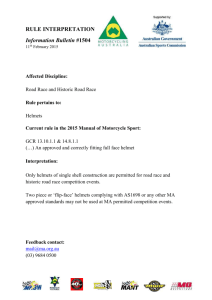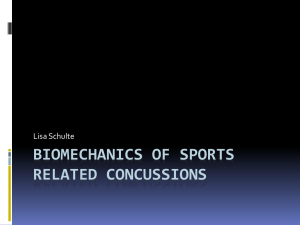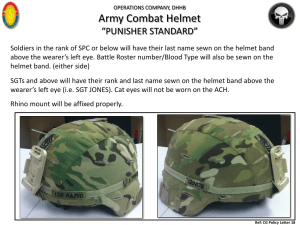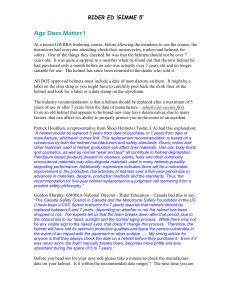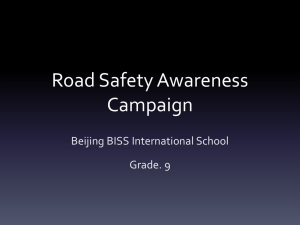Comparing impacts for helmeted and non
advertisement
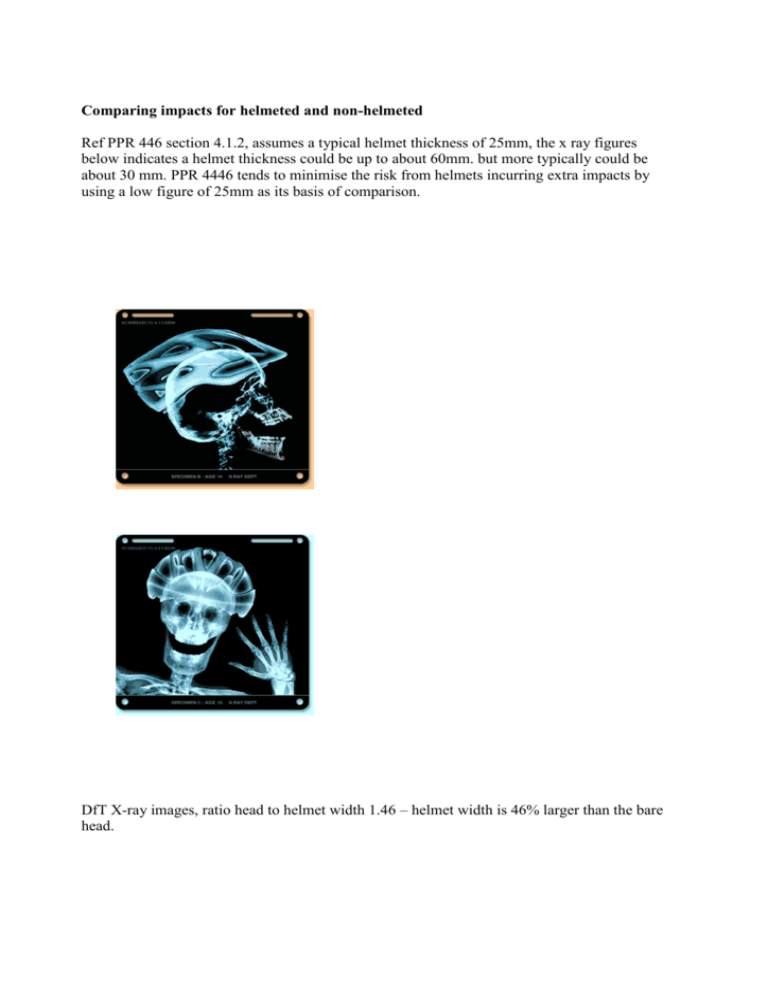
Comparing impacts for helmeted and non-helmeted Ref PPR 446 section 4.1.2, assumes a typical helmet thickness of 25mm, the x ray figures below indicates a helmet thickness could be up to about 60mm. but more typically could be about 30 mm. PPR 4446 tends to minimise the risk from helmets incurring extra impacts by using a low figure of 25mm as its basis of comparison. DfT X-ray images, ratio head to helmet width 1.46 – helmet width is 46% larger than the bare head. Diagramme A, Clarke Velocity 2007 paper (fig 4 shown below), has a ratio of head to helmet width of 1.27 Page 5 provides a comparison of the impact forces, helmeted total 7.83 and for non-helmeted, total 5.087. Total helmeted forces were 54% HIGHER based on a head to helmet width ratio of 1.27 See; http://www.nationaler-radverkehrsplan.de/eu-bundlaender/eu/velocity/presentations/velocity2007_pp_17c_long_public.pdf Comparing forces for a head to helmet width ratio of 1.36 (Clarke 2007 method) Comparison of forces to the head/helmet for helmeted and non-helmeted in the X and Y directions, based on a simple frontal approach motion of possible impacts and a ratio of head to helmet width of 1.36 (between size shown in Clarke 2007, 1.27 and DfT X ray images, 1.46) Helmeted:Angle…… Sin 5….. .0871 10…… .1736 15…… .2588 20…….. …. .3420 25……. .4226 30 …… .5000 35…… .5735 40…… .6427 45……… .7071 50…… .7660 55……… .8191 60…… .8660 65…… .9063 70…… .9396 75……. .9659 80…… .9848 85…… .9962 90……. 1.0000 ………… ……. (Sin Q)2 ……. (Sin Q x Cos Q) Cos Y frontal….. X sidewards .9962 .0076 .0866 .9848 .0301…. .1709 .9659 .0669 .2500 .9396 .1169 …. .3213 .9063 .1786 .3830 .8660 .2500 …. .4300 .8191 .3290 .4698 .7660 .4130…. .4923 .7071 .5000 .5000 .6427 .5867…. .4923 .5735 .6710 .4698 .5000 .7500…. .4330 .4226 .8214 .3830 .3432 .8828 …. .3213 .2588 .9330 .2500 .1736 .9698…. .1709 .0871 .9924 .0868 .0000 1.0000… .0000 Totals 9.4993 5.7109 Total 15.21 from 18 impacts, Non-helmeted:Corresponding impacts for above, angles below 50 degrees would be misses or near misses. ……. (Sin Q)2 ……. (Sin Q x Cos Q) Angle…… Sin Cos Y frontal….. X sidewards 50 – 0 … ……0……1.0 0 0.0 55 – 33 .5446 .8386 .2966 .4567 60 – 46 .7193 .6946 .5174 .4997 65 – 56 .8290 .5592 .6873 .4635 70 – 63 .8910 .4540 .7939 .4045 75 – 71 .9455 .3255 .8940 .3078 80 – 76.5 .9723 .2334 .9454 .2269 85 – 83.5 .9935 .1132 .9872 .1125 90 – 90 1.0000 .0000 1.0000 .0000 Totals 6.1219 2.4716 Total 8.59 from 8 impacts, A comparison of the impact forces, helmeted total 15.21 and 8.59 for non-helmeted. Total helmeted forces were 77% HIGHER based on a head to helmet width of 1.36 Comparing impacts Based on the above comparison, total combined forces for helmeted impacts were 77% higher than for non-helmeted forces, 15.21 to 8.59. Total impacts for helmeted were 18 compared to 8 for non-helmeted, up 125%. . Rotational acceleration levels Testing for rotational accelerations involving both vertical and lateral movement relates more directly to a cyclist falling from a moving bicycle. A slight difference in the size of helmet has resulted in major difference in the level of measured rotational acceleration, a major factor in brain injury. StClair and Chinn 2006 report, Table 4.9, provides test results for helmet sizes E and J, 54cm and 57cm respectively. Average rotational acceleration for size E were 5333 rad./sec 2 compared to J size of 13505 rad./sec 2. A difference of just 3 cm resulted in the rotational levels increasing by 150%. The difference between a helmeted and non-helmeted head is roughly 20 cm. StClair and Chinn considered the maximum level of rotation would occur from impacts onto a 15% slope. For helmets with a foam thickness of 30mm this effectively means they will make contact sooner than a bare head by about 113mm of travel. The earlier impact could reduce the time for the head to try and avoid impacting but only to a small degree. The impact location could also be important with a bare head tilting and moving to minimise contact force. The actual turning moment to produce rotation could be 40% higher by wearing a helmet, eg 75mm radius v 105mm radius with a helmet, factor 1.4. Helmets in general are not designed to limit rotational acceleration and Lanei reported "it has been recognised since the work of Holbourn (1943) that rotational acceleration of the head plays a major part in brain injury". Lane details the threshold limits suggested by Lowenhielm of 4500 rad/sec/sec for AIS 5. AIS 5, being critical injury level. StClair and Chinn page 3, suggest a maximum rotational level tolerance for human adult head of 10000 rad./sec 2, children’s tolerance may be lower. For the J size results the average resultant force was 4228N. Details from PPR 446, section 4.1 (see below) suggest 12262N force would be involved in a 250g linear head acceleration compared to the force of 4226N (34% of 12262N) to cause serious injury or death due to a rotational acceleration. PPR446 does not consider the length of time for accelerations causing diffuse axonal injury, refer Curnow 2009. StClair and Chinn research suggests a slight increase in helmet size, E to J, can lead to a major increase in risk of brain injury. A bare head provides the minimal risk of head contact in the event of a fall or accident and the minimum turning moment. The effects of crushing the EPS form may help to reduce rotation but many helmets on inspection do not show signs of being crushed and most helmets do show signs of impacts to the side, areas where a near miss may occur for a bare head. Research over the past 50 years indicates angular acceleration is more damaging than linear acceleration. Bases on the increase in impacts and tests from rotational experiments it would not be safe to assume the effect of padding provided by a helmet, will outweigh the effect of the geometry and the increased size of helmet compared to a bare head. The highest level of rotational acceleration from StClair and Chinn research of 20642 rad./sec 2 came from impacting aiming to catch a central vent in the helmet, this level of risk may not arise from a normal rounded head shape. Neck injuries PPR 446 page 10 indicates neck injuries would reduce with helmet padding, forces mentioned 3720N compared to 8124N without padding. In contrast actual neck injury data indicates helmet use may not provide any benefit. Attewellii states "Three studies provided neck injury results that were unfavourable to helmets with a summary estimate of 1.36(1.00, 1.86), but this result may not be applicable to the lighter helmets currently in use". From this it is not clear if any helmet could increase the risk of a neck injury or if the risk is proportional to the helmet weight, or a combination of factors. The conclusions indicated on neck injuries in PPR 446 appear to conflict with the actual evidence from hospital cases. PPR 446 section 4.1 There appears to be some doubt about the information provided in Figure 4.1 showing a drop height of 376 mm (15 inch) results for a bare head in an acceleration of 250g. This suggest for dropping a 5kg mass from 376mm height a force would occur of 12,262N or 1.23 tonf. In practice this may not occur due to the scalp/hair, dura layer and cerebral fluid tends to dampen impacts and the ability of the skull to deform thus lowering the rate of acceleration. In particular it seems that side impacts where the skull stiffness is lower could reduce acceleration to below 100g. Such impacts are probably below or near the test line on helmets and therefore may not be tested for. Fig 4 indicates a level of danger to be far higher from a drop of 376mm than would normally occur in practice. Executive summary of 446 stating; “No evidence was found of increased risk of rotational head injury with a helmet compared to without” This statement may not be reliable when evidence is examined in detail and considered in full. The increased risk stems from the extra impacts that occur due to the size of helmets compared to a bare head but the report fails to invest this aspect fully and disregards other evidence. Corner 1987 found higher rotational levels for helmeted motorcyclists compared to nonhelmeted in impacts to the jaw. For bicycle helmets it reported very high levels, 30% higher than for those found in similar tests using a full-face polymer motorcycle helmet. (PPR 446 does not refer to Corner1987) StClair and Chinn 2006 reported helmeted rotational acceleration levels up to 20642 rad./sec 2, much higher than the level that could result in death. A level of 16224 rad./sec was recorded from an impact to the right side of helmet and without wearing a helmet this could perhaps have been a near miss for a bare head. Wasserman 1988iii, provided some evidence of helmets incurring more impacts. The paper reported interviewing 516 cyclists over the age of 10 years regarding helmet use. At the time of the interview, 40 out of 516 (7.8%) were wearing helmets. The 516 were asked if they had fallen and struck their heads in the previous 18 months. Out of 21 who reported such falls, 8 were helmeted at the time of their fall and 13 were not. For helmeted riders this represented 20% (8 from 40) of their group and for non-helmeted 2.8% of their group (13 from 476). Comparing the 20% to the 2.8% shows a ratio of 7 to 1 (700%) of helmeted riders being more involved in accidents. Hillmaniv[i] stated "they do not protect the head from rotational trauma which can seriously damage the brain and brain stem and which is quite common when cyclists are hit a glancing blow from a motor vehicle rather than in direct collision with it (McCarthy, 1992)". Curnow 2005 table 1 reported an increase risk for brain injury with thin shell helmets but no increase in severe brain injury. Table 2 shows the reduction in cyclist deaths due to head injury was less than that due to other injury and lower than for pedestrians and for all road users. Canadian data shows the length of stay in hospital increased following helmet laws, from 4.3 days to 6.9 days. i Lane J C, 'Helmets for child bicyclists some biomedical considerations' CR47, FORS, Canberra, Oct 1986. ii Attewell R, Glase K, McFadden M, Bicycle helmets and injury prevention: A formal review, CR 195, ATSB, June 2000. iii Wasserman RC; Bicyclists, Helmets and Head Injuries: A Rider-Based Study of Helmet Use and Effectiveness; AJPH Vol 78, No 9, pp 1220-21, September 1988. iv[i] Hillman M, 'CYCLE HELMETS the case for and against' Policy Studies Institute, London 1993.

